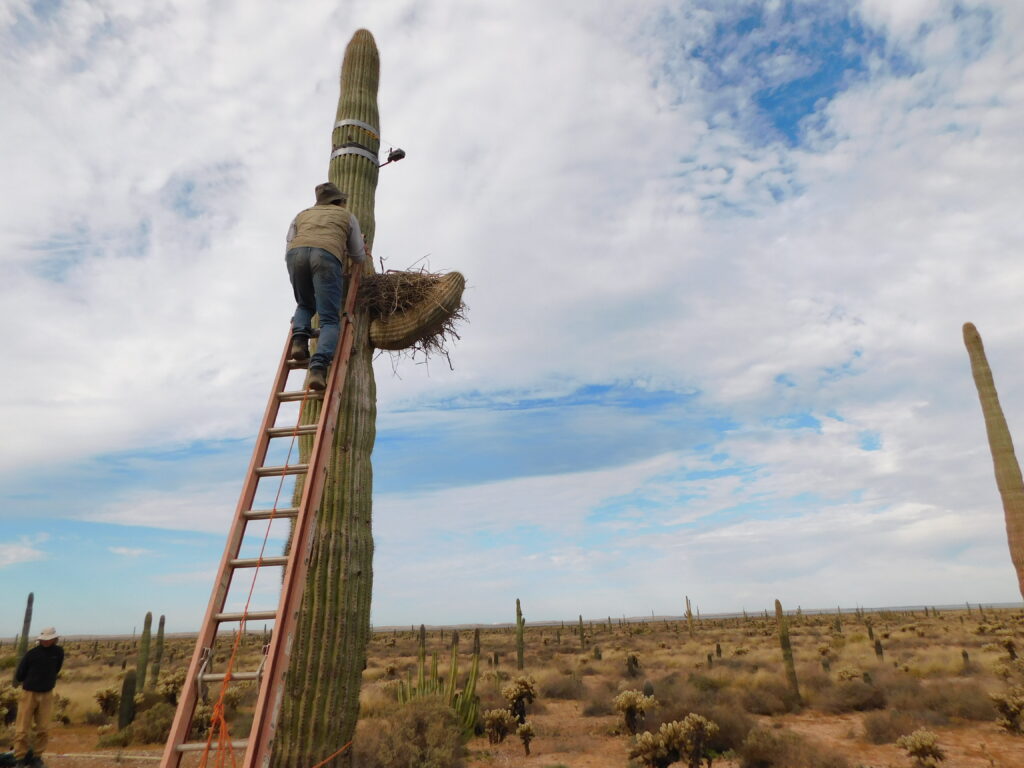
Effects of contaminants and human activities on reproduction of Ospreys (Pandion haliaetus) in coastal of Sonora. CIAD-UA-CAZMEX/ECG/2021.
Resumen.
We characterized nests and aspects of reproduction by Osprey (Pandion haliaetus) in northwestern Sonora, between Bahía San Jorge and the ejido Rodolfo Campodónico. This area is within the Ramsar site known as “Wetlands of Bahía San Jorge”, with vegetation characterized by desert scrub and columnar cacti, with sahuaro cactus (Carnegia gigantea) providing the main nest substrate for this bird of prey. We encouraged participation from the local community, specifically from ejido Rodolfo Campodónico, to enrich their knowledge of the species, natural environment, and methods to monitor reproduction, including use of camera traps.
Given the constraints of the pandemic lockdown, we were able to work for six months on the seasons of 2020-2021 and 2021-2022. During November and December of 2020-21, we monitored three active nests, but due to the lack of monthly continuity in the monitoring, the expected reproductive parameters were not obtained. During January and March of 2021-22, we monitored four active nests, with an average clutch size of 2.2 (SD = 1.7) and hatching success of 22%. Heavy metals such as mercury (Hg), lead (Pb), cadmium (Cd), cooper (Cu) and selenium (Se) found in feathers from molts of adult birds and juveniles were below levels thought to produce adverse effects on their Ospreys.
The study area contained 25 nests, some of which were of Gray Heron (Ardea herodias), which are distinguishable from Osprey nests in their size, construction materials, and orientation, with osprey nests oriented to the zenith, built of larger branches and roots, and containing more remains of fishing gear. Height of active Osprey nests averaged 6.2 ± 2.6 m (n = 8) and inactive nests 4.8 ± 1.5 m (n = 17).; diameter of saguaros used for active nests averaged 1.6 ± 0.2 m (n = 8) and inactive nests 1.6 ± 0.3 m (n = 17). We are currently producing orthomosaics to characterize sites surrounding nests, which includes calculating the local normalized vegetation index (NDVI), which ranged from 0.032-0.736 across the area.
As part of the dissemination of the species knowledge in the area, the experience of working together with the Intercultural Center of Deserts and Oceans (CEDO AC) has led to a common interest in monitoring the natural Osprey nests in Puerto Peñasco near Las Conchas residential complex, as well as for the artificial nests built in the “Islas del Mar” real estate development. Monitoring will be a joint effort for the follow-up of the 2021-2022 reproductive season and with the possibility of extending monitoring for one more year, as well as the collection of feathers and, if possible, of eggshells, to continue the study of the presence of environmental contaminants and the possible exposure to these contaminants by the Ospreys.
Colaboración:
CIAD-UA-CAZMEX